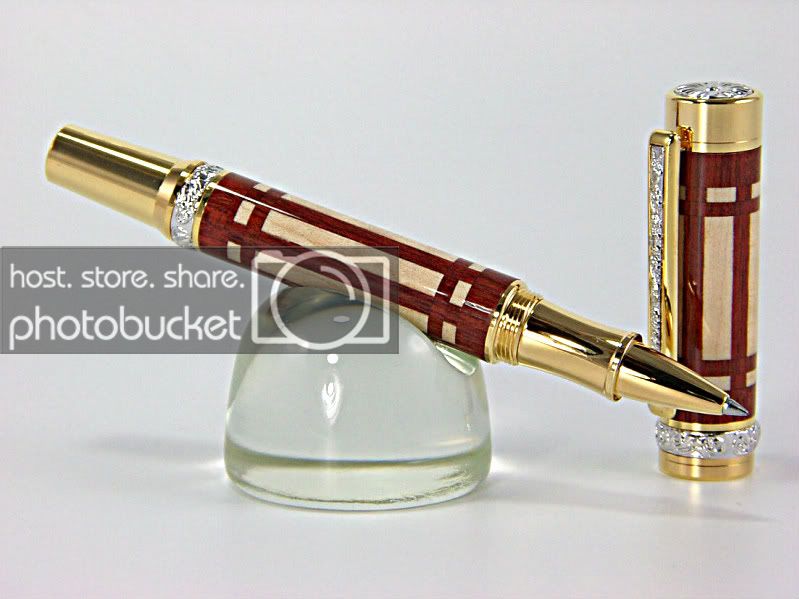ChewTerr
Member
So. I started trying to make an overly complicated (for me) pen, and struggled as a result. I wanted to do a Sierra with two woods in it, cut at a 45 degree angle, so that there is a chevron in wood B inserted into a blank of wood A. After I was mostly done with the pen, I read in the library that this seems to be a segmented pen design? So, the pen kind of worked, but had some major flaws.
1) The blank fit weirdly on the tube, so sanding to the tube ended up being somewhat uneven. This caused it to not match well with the kit.
2) The gray (main) wood of the blank had holes, bubbles, and knots. I tried to fill with sawdust as I could as instructed here: http://www.penturners.org/forum/f14/hole-y-moley-135054/.
3) Perhaps most crucially, the two woods seemed to have drastically different hardnesses. There were places where the gray wood cut or sanded much more quickly than the adjacent black/tan wood. So there are two places where the softer wood has shallow depressions from sanding faster.
4) The soft gray wood seemed to chip off when I epoxied the whole blank together, so there is an area at the border of the two where you can see the tube through epoxy. I hadn't noticed that until it was sanded down and was too late to fill with sawdust.
Overall I am pretty happy with the lessons I have learned in the overly ambitious attempt, but definitely sad that the pen suffered for it. Among things to do differently next time, I will make a temporary fence for my chop saw by clamping two boards nearby. This was demonstrated on the segmented spider pen in the library and will make the cuts much easier/safer, in addition to providing smoother cuts to glue together.
I told you all of this so that I can ask you the next bit - the two woods definitely seemed to be different hardnesses, which caused the pen to be uneven and amateurish. How do you handle making pens out of multiple woods of varying softness? Any pointers for this or my other mistakes?
Additionally, I apologize if I am creating forum topics too prolifically. My past two pens both involved techniques that were very new to me, so each seemed to merit questions to the forum.
Thanks!
-Will
1) The blank fit weirdly on the tube, so sanding to the tube ended up being somewhat uneven. This caused it to not match well with the kit.
2) The gray (main) wood of the blank had holes, bubbles, and knots. I tried to fill with sawdust as I could as instructed here: http://www.penturners.org/forum/f14/hole-y-moley-135054/.
3) Perhaps most crucially, the two woods seemed to have drastically different hardnesses. There were places where the gray wood cut or sanded much more quickly than the adjacent black/tan wood. So there are two places where the softer wood has shallow depressions from sanding faster.
4) The soft gray wood seemed to chip off when I epoxied the whole blank together, so there is an area at the border of the two where you can see the tube through epoxy. I hadn't noticed that until it was sanded down and was too late to fill with sawdust.
Overall I am pretty happy with the lessons I have learned in the overly ambitious attempt, but definitely sad that the pen suffered for it. Among things to do differently next time, I will make a temporary fence for my chop saw by clamping two boards nearby. This was demonstrated on the segmented spider pen in the library and will make the cuts much easier/safer, in addition to providing smoother cuts to glue together.
I told you all of this so that I can ask you the next bit - the two woods definitely seemed to be different hardnesses, which caused the pen to be uneven and amateurish. How do you handle making pens out of multiple woods of varying softness? Any pointers for this or my other mistakes?
Additionally, I apologize if I am creating forum topics too prolifically. My past two pens both involved techniques that were very new to me, so each seemed to merit questions to the forum.
Thanks!
-Will




